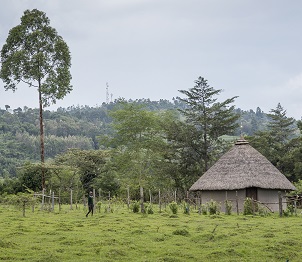
Planet-positive farming
Ask the farmers of Migori County, southwestern Kenya to name their biggest challenge and the answer is near-universal. “The soil in our village doesn’t have any nutrients. It doesn’t produce enough yield,” explains one Hand in Hand member. Another gets right to the point: “Our soil has been destroyed.”
Travel to neighbouring counties – or countries – and the story is largely the same. Seventy percent of working Kenyans are smallholder farmers. Continuous cropping, soil erosion and the overuse of synthetic fertilisers have degraded more than 35 percent of their land. Compounded by the growing threat of climate change – and all the floods, droughts and pests it brings with it – sub-Saharan Africa’s soil troubles threaten to become an all-out crisis. At a time when global demand for food is expected to increase by 50 percent in the next 30 years, agricultural productivity across the continent is on the decline. In order for future generations to thrive, Kenya’s and the world’s farmers must urgently adapt.
Luckily, a growing body of evidence is guiding their way. If only we can find the will, humanity stands on the cusp of an agricultural revolution for the 21st Century – one that puts farmers on the front foot against climate change even while restoring their degraded soil.
With help from Hand in Hand and our partners at the IKEA Foundation and elsewhere, 13,000 farmers in Migori County and across western Kenya will be leading the way.
Good for the environment
Take all the carbon in the atmosphere and multiply it by two. That’s the amount of carbon stored in the top 30 centimetres of the planet’s soil. Second only to oceans, soil surpasses all the world’s forests and vegetation in its ability to capture carbon dioxide from the air. But its role in the fight against climate change remains widely overlooked.
Released into the atmosphere as CO2, carbon poses an existential threat to all life on Earth. Stored in the soil, it sustains us – improving the health, nutrition, and productivity of crops and other plants. Planet-positive farming, known more technically as regenerative agriculture, stems from this simple truth, employing a range of techniques that continually improve and regenerate the health of the soil by restoring its carbon content.
At its most basic, that means planting a diverse range of trees, perennial plants and crops to ensure vegetation stays in the ground year-round, pulling CO2 from the air and storing it as carbon in the soil. Other approaches include integrating livestock and closely managing their grazing, making the most of the natural fertiliser they provide.
![]()
Plant diverse vegetation
Restore carbon to the soil
Integrate livestock
Good for people

Were its benefits purely environmental, planet-positive farming would still be worth pursuing. But as organisation focused on women’s economic empowerment, Hand in Hand is equally motivated by another factor: our members’ financial strength. Here too, the advantages are impossible to ignore.
Diverse, year-round crops mean diversified, year-round incomes. At the same time, leveraging natural farming methods reduces upfront input costs while minimising dependency on synthetic, commercial fertilisers that depend on global supply chains.
Beholden only to local inputs and actively beneficial to the environment, planet-positive farms also outscore their more typical counterparts on another crucial metric: sustainability. Smallholder farms are more productive for longer when the soil that makes them grow remains healthy over the long term.
Our planet-positive projects in Kenya
For reasons both environmental and financial, Hand in Hand is pleased to be helping 13,000 smallholder farmers in western Kenya, 80 percent of them women, become planet-positive farmers by 2025.
First, we’ll train them on a range of regenerative techniques so they can apply what works best on their farms. Next, we’ll invite them to try those techniques on our conveniently located and freely accessible test plots so they can learn without risking their crops.
In order to measure their success, we’ll monitor our members’ soil quality, yields and business incomes. Finally, we’ll empower our members to take the planet-positive agenda into their own hands, advocating for regenerative agriculture both within their community and with stakeholders in government and the private sector.
By the time our current projects are complete, based on everything we learn, we want to prove that planet-positive farming helps farmers improve their incomes and build local economies, even while taking the fight to climate change.
Our dream is for the world’s 500 million smallholder farmers to adopt the same practices, transforming life in their communities and beyond.
Making it a reality starts here.
